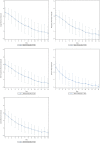Psychometric evaluation of a caregiver diary for the assessment of symptoms of respiratory syncytial virus
- PMID: 29757327
- PMCID: PMC5934931
- DOI: 10.1186/s41687-018-0036-7
Psychometric evaluation of a caregiver diary for the assessment of symptoms of respiratory syncytial virus
Abstract
Background: There are no clinical outcome assessment (COA) tools developed in accordance with Food and Drug Administration (FDA) guidance suitable for the evaluation of symptoms associated with respiratory syncytial virus (RSV) infection among infants. The Gilead RSV Caregiver Diary (GRCD) is being developed to fulfill this need; the present research evaluates the GRCD and documents its reliability, validity, and responsiveness among children < 24 months of age with acute RSV infection.
Methods: A prospective, observational study was conducted in the United States during the 2014-2015 northern hemisphere winter season. Subjects were < 24-month, full-term, previously healthy infants with confirmed RSV infection and ≤5 days of symptoms. The GRCD was completed twice daily for 14 days by caregivers. Additional data were collected during the initial visit, subsequent visits, and end-of-study interview. Test-retest reliability (kappa and intraclass correlation coefficients [ICCs]), construct validity (correlations and factor analyses), discriminating ability (analyses of variance and chi-square), and responsiveness (effect sizes and standardized response means) were evaluated.
Results: A total of 103 subjects were enrolled (mean age 7.4 ± 5.3 months). GRCD items were grouped into different subscales according to question content, which, with the exception of the behavior impact domain (ICC = 0.43), demonstrated internal consistency (alphas = 0.78-0.94) and test-retest reliability (ICCs = 0.77-0.94). Hypothesized correlations with parent global ratings of RSV severity ranged from 0.45 to 0.70 and provided support for construct validity. Support for discriminating ability was limited. Effect sizes ranged from - 1.48 to - 4.40, indicating the GRCD was responsive to change.
Conclusions: These psychometric analyses support the validity, reliability, and responsiveness of the GRCD for assessing RSV symptoms in children < 24 months of age.
Keywords: Caregiver diary; Clinical outcomes assessment; Observer-reported outcome; Psychometric evaluation; Respiratory syncytial virus.
Conflict of interest statement
This project was reviewed and approved by an institutional review board and all procedures were in accordance with the ethical standards of the 1964 Helsinki declaration and its later amendments. Written informed consent was obtained from all participants prior to study participation.Not applicable — this manuscript does not contain any individual person’s data.Valerie Williams, Carla DeMuro, Sandy Lewis, and Nicole Williams are employees of RTI Health Solutions. Todd Wolynn is an employee of Kids Plus Pediatrics. Paul Wisman is an employee of Pediatric Research of Charlottesville. Stan L. Block is an employee of Kentucky Pediatric & Adult Research. Shelly Senders is an employee of Senders Pediatrics. Seth Toback was an employee of Gilead Sciences Inc. at the time this work was conducted. Jason Chien is an employee of Gilead Sciences Inc.Springer Nature remains neutral with regard to jurisdictional claims in published maps and institutional affiliations.
Figures


References
-
- American Lung Association (2016) Learn About Respiratory Syncytial Virus (RSV). Available at: http://www.lung.org/lung-health-and-diseases/lung-disease-lookup/rsv/lea.... Accessed 16 Feb 2018.
-
- MedlinePlus (2016) Respiratory Syncytial Virus Infections. Available at: https://medlineplus.gov/respiratorysyncytialvirusinfections.html. Accessed 16 Feb 2018.
-
- Centers for Disease Control and Prevention (2016) Respiratory Syncytial Virus Infection (RSV). Available at: https://www.cdc.gov/rsv/about/symptoms.html. Accessed 16 Feb 2018.
LinkOut - more resources
Full Text Sources
Other Literature Sources

